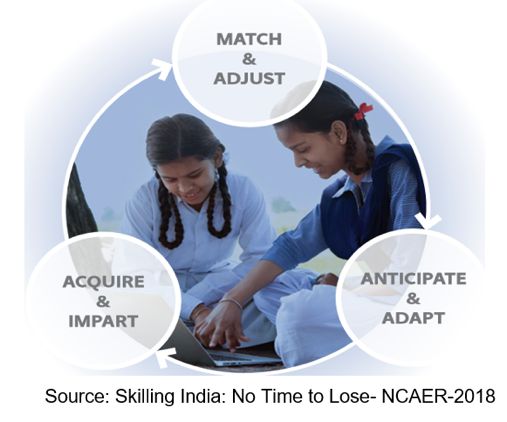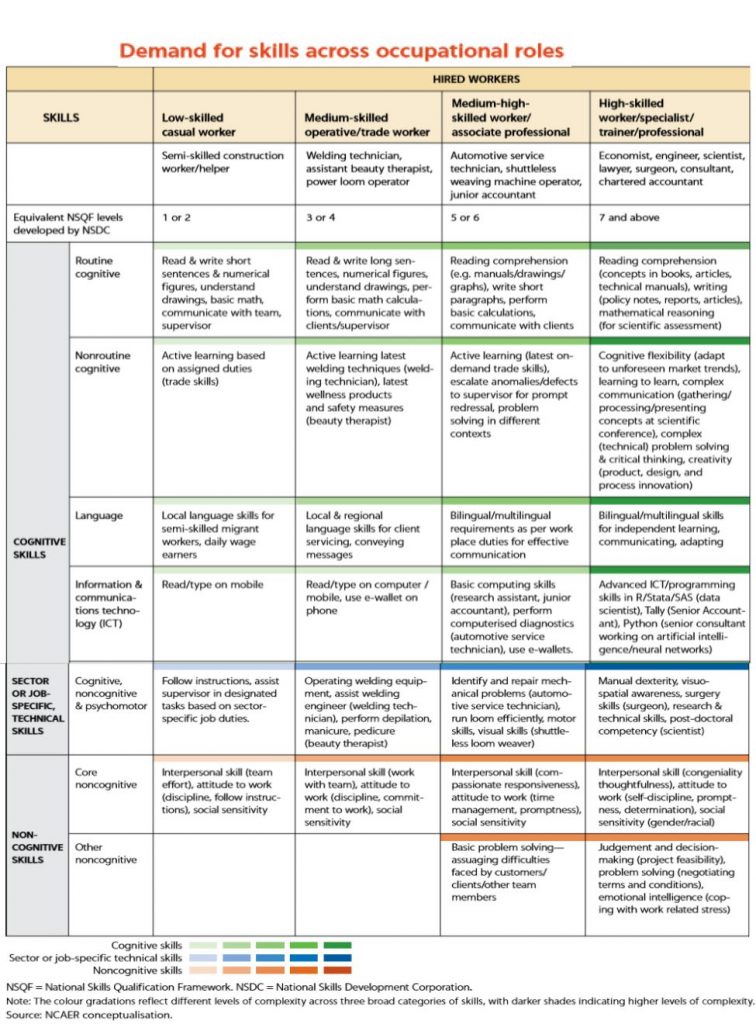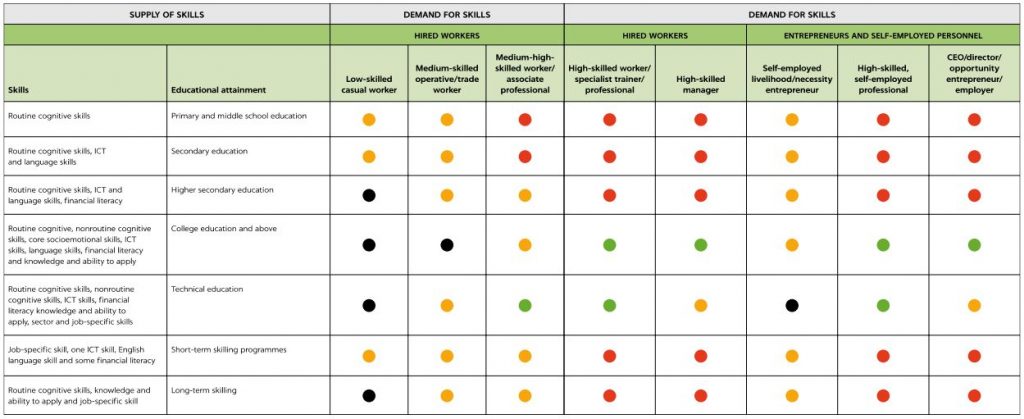Matching and Adjusting skills– is part of the three-component framework of the Skilling India: No Time to Lose- NCAER 2018[i] report aiding decision-makers in creating effective skilling systems to shift Indian workers from lifetime employment to lifetime employability.


Read Part I – Introduction and Part II – Acquiring & Imparting skills
Supply-Demand Dichotomy
The report provides a clear-cut representation of what sectors at what level are creating demand for which type of skill. Employers seek a skills basket comprising of cognitive, soft skills and role/occupation/sector specific competencies for a particular level of responsibility.


On the supply side, alarmingly, we see the scale of the skills mismatch problem in the sectors generating the most jobs.


Why Are Degrees Not Landing Jobs?
India’s skills demand-supply incongruence is symptomatic of a deeper malaise. The report states that increasing educational attainment of the general population has not resulted in economic progress as high unemployment rates among the educated continues to plague the nation. Notwithstanding minor improvements, the India Skills Reports[ii] find employability languishing below 50% for final year students aged 18-29 in various educational programmes.
Employability of the better educated has taken a serious hit and much of the onus sits squarely on the education and training system (mainstream or vocational) rigid in their use of theory-heavy, out-of-date and rote teaching methods with little exposure to holistic development comprising of a mix of employer relevant foundational and advanced, general and specialised skills.
Think about it, after years of toiling through an education 65%-70%[iii] of Indian youth are deemed not job-ready. It is a travestythat a vast majority of our youth are being failed by an education and training system dragging its feet, resulting in as the report acutely states ‘a central mismatch of the Indian economy: an army of educated unemployed and an acute shortage of skilled people.’ Both the TVET and mainstream education systems show a serious disconnect with industry. Which brings us to the crucial question of how best to equip workers with the skills they need to match demand, thus pushing businesses and workers towards increased market relevance and productivity.
More Than Vocational Skills Training
The report elucidates that merely skilling does not cut the mustard. It critiques the short-term view of some of the major mass vocational skilling programmes in the country. Short-term skilling it says, may equip an individual with just enough skills to land a job, but rarely will it build long-term employability. As content and design of most skilling programmes are below international standards, and lacking foresight, technological or other labour market changes can leave candidates floundering. One way, the report suggests, to remain relevant to market movement is to build higher-order cognitive skills such as ‘self-learning, lifelong learning, and learning to learn, thereby increasing adaptability.’ And these essential skills cannot be taught in a limited view approach to vocational skilling.
Plugging the Gap
India’s skilling programmes cannot rest on laurels on the back of placement rates alone. Programme dropout rates and turnover from employment are equally important to gauge relevance of skilling programmes. Which means industry buy-in at the design stage of skilling programmes is fundamental to their success. The National Skill Development Corporation (NSDC), to mitigate the skills-jobs lacuna, has undertaken state-level skill gap analyses across Indian industries. Training is designed on identified gaps and conducted by NSDC-certified training providers. However, such industry-specific task-based vocational training in specific occupations amounts to a stopgap measure addressing immediate skill shortages. Also, turnover from short-term skilling can be extremely high- the report states only 32% of NSDC-certified workers are still employed 1–2 years post training.
The report hence recommends a multi-pronged skill development approach involving recognising prior learning, longer duration on-the-job training and bridge courses to build core cognitive and soft skills along with technical training.
Strongly lending voice to our own advocacy of apprenticeships as a comprehensive skilling model, inherently suited to solve many of the skilling problems discussed above, Joint Secretary, MSDE, Rajesh Aggarwal, in his keynote at a recent NETAP-IAF event stressed, “I do not see how apprenticeships are not a win-win situation for both industry and trainees.”
“Employers will promote apprenticeships in an area where there is a need for people and scope for employment. And the whole supply chain matching takes place at the apprenticeship stage.”
“A work immersed environment makes youth aware if that job is meant for them. If it is meant for them they will go through the process whereby they have acquired the skills and have proven their loyalty to the sector. So youth become just right for that sector.”
Coming up
Anticipating and Adapting skills– the concluding section of the NACER’s three-part framework.
References
[i] Main source: ‘Skilling India: No Time to Lose’- 2018- National Council of Applied Economic Research
[ii] India Skills Report 2017,2018,2019- All India Council for Technical Education (AICTE), Association of Indian Universities (AIU) along with Wheebox, PeopleStrong and Confederation of Indian Industry (CII)
[iii] On National Youth Day, know how India can close its massive skill gap and deal with unemployment, Jan 12 2019, India Today













